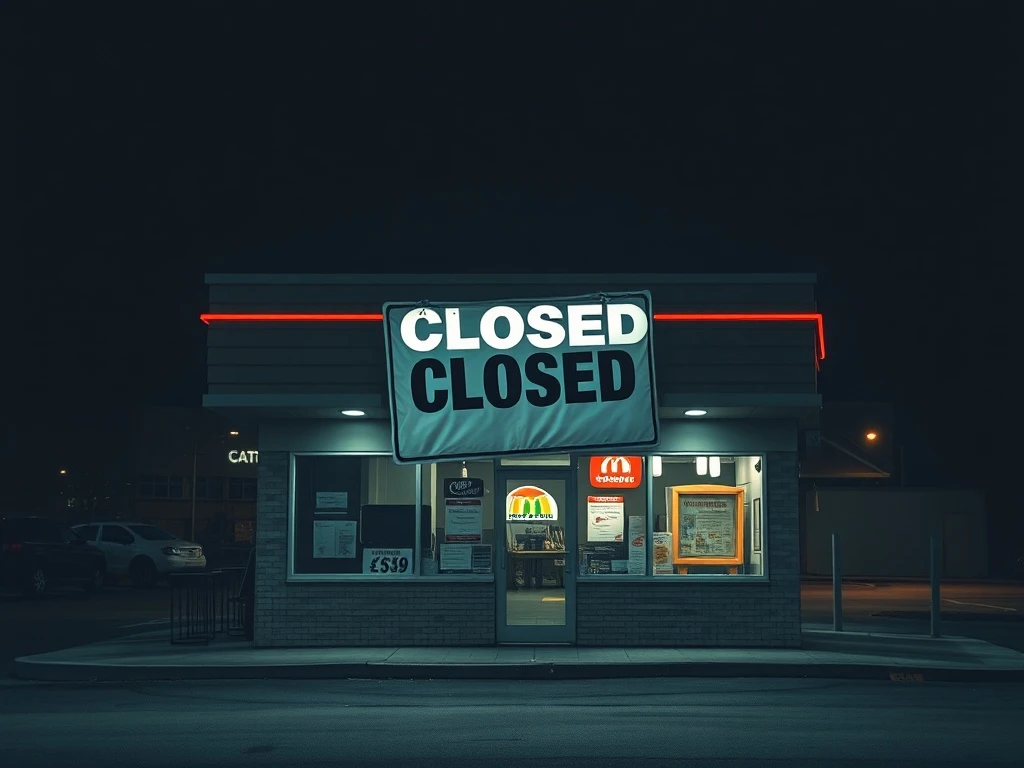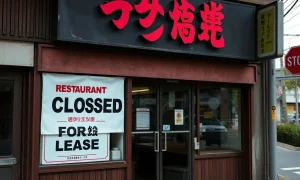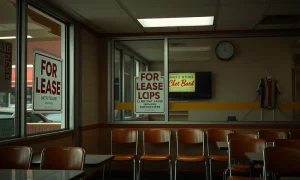The culinary landscape often experiences significant shifts, but few are as stark as a familiar eatery suddenly shutting its doors forever. Recently, a major development sent ripples through the restaurant sector. A prominent burger chain, once a beloved fixture for many, officially filed for Chapter 7 bankruptcy. This decisive legal action signals a complete liquidation of its assets. Consequently, this **fast-food bankruptcy** marks the definitive end of an era for the chain. It impacts countless employees, suppliers, and loyal customers alike. The news profoundly underscores the volatile and challenging nature of the modern food service industry.
Unpacking the Fast-Food Bankruptcy Filing
The burger chain’s decision to file Chapter 7 bankruptcy represents a critical turning point. This specific legal action differs significantly from other bankruptcy types, such as Chapter 11, which focuses on reorganization. Specifically, Chapter 7 means the business will cease all operations immediately. Its remaining assets will then be sold off. Proceeds from these sales go towards repaying creditors. Therefore, the filing essentially confirms the permanent closure of all the chain’s locations. This process is often a last resort for companies facing insurmountable debt and operational challenges. It highlights the severe pressures within the current market environment.
The Economic Pressures Leading to Closure
Several profound factors likely contributed to this unfortunate outcome. For instance, **rising operational costs** have plagued many businesses across various sectors. These include increasing labor wages, which place a heavy burden on staffing budgets. Furthermore, the soaring prices of raw ingredients, from beef to cooking oil, significantly erode profit margins. Intense market competition consistently challenges established brands. New entrants, innovative delivery services, and even grocery store prepared meals vie for consumer dollars. Many diners now seek healthier options, greater value, or different dining experiences altogether. This combination of persistent pressures can erode even strong business models over time. Ultimately, these cumulative challenges led to the chain’s critical financial distress and eventual **fast-food bankruptcy**.
Far-Reaching Consequences of a Business Liquidation
The immediate effects of this **fast-food bankruptcy** are far-reaching, impacting numerous stakeholders. Employees are perhaps the most directly affected group. Thousands of jobs will disappear across various locations, leaving many workers facing sudden unemployment. This creates significant personal hardship and economic uncertainty for families. Additionally, the liquidation process profoundly impacts numerous suppliers. These businesses relied heavily on the burger chain for consistent orders and revenue. Now, they face substantial unpaid invoices and a sudden loss of a major client. This can create a severe domino effect through the supply chain, potentially jeopardizing the stability of smaller businesses.
Customers also feel a distinct sense of loss. For many, the chain was more than just a place to eat; it represented nostalgia, convenience, or a familiar gathering spot. Its disappearance leaves a void in local communities. Moreover, the local economies where these restaurants operated will experience a noticeable downturn. Tax revenues will decrease, and prime commercial spaces will sit vacant for extended periods. These empty storefronts can negatively affect surrounding businesses, potentially leading to further economic contraction. Consequently, the ripple effect of one company’s closure extends far beyond its immediate operations, truly demonstrating the interconnectedness of the business ecosystem.
Navigating the Broader Fast-Food Landscape
This specific **fast-food bankruptcy** is not an isolated incident within the industry. Instead, it reflects broader trends impacting the entire restaurant sector. The post-pandemic landscape presents unique and ongoing hurdles. Many establishments grapple with reduced foot traffic and permanently altered consumer habits. Furthermore, the rapid rise of food delivery services has fundamentally changed how people access meals. While offering convenience, these services often come with high commission fees for restaurants. This further squeezes already tight profit margins. Therefore, businesses must adapt quickly and strategically to survive and thrive in this evolving environment.
Innovation remains absolutely crucial for sustained success. Restaurants must explore new business models and identify operational efficiencies wherever possible. For example, some chains focus on streamlined digital ordering platforms to enhance customer experience. Others invest heavily in loyalty programs or continually diversify their menu offerings to capture new demographics. Sustainability initiatives and health-conscious choices also increasingly attract modern consumers. Ultimately, the ability to pivot swiftly and meet evolving demands determines long-term viability. This bankruptcy serves as a stark reminder for all industry players. It highlights the constant need for strategic planning, foresight, and continuous adaptation in a dynamic market.
The Legal Framework: Chapter 7 and Asset Distribution
When a company files for Chapter 7 bankruptcy, a court-appointed trustee takes immediate control of the business. This trustee’s primary role involves gathering all non-exempt assets belonging to the company. These assets can include a wide range of items: real estate holdings, kitchen equipment, existing inventory, and even valuable intellectual property like brand names or proprietary recipes. The trustee then liquidates these assets, meaning they sell them off through various means, such as auctions. The funds generated from these sales are subsequently distributed among the creditors. This distribution follows a specific legal order of priority, ensuring fairness under the law. Secured creditors, for instance, often receive payment before unsecured creditors, reflecting their legal claims.
For the burger chain in question, this means all its physical properties, specialized kitchen equipment, and branding elements will be sold off. Even its well-known recipes or brand name might become part of the liquidation process. However, the fundamental goal of Chapter 7 is not to reorganize or restart the business. Rather, it is to provide the maximum possible recovery for those owed money by the now-defunct entity. This finality definitively differentiates Chapter 7 from other bankruptcy chapters. It permanently closes the book on the company’s existence. Consequently, it clears the way for new ventures or alternative uses for the acquired assets, marking a clear end to the business.
Key Takeaways from This Fast-Food Bankruptcy
The recent **fast-food bankruptcy** offers invaluable lessons for the broader business community. First, it underscores the paramount importance of financial resilience. Companies must proactively build strong cash reserves and manage debt prudently to weather economic storms. Secondly, adaptability is absolutely paramount in today’s rapidly changing market. Markets evolve constantly, and businesses must change with them. Sticking rigidly to outdated models can prove fatal. Thirdly, understanding consumer behavior is undeniably key to sustained success. Successful brands consistently monitor and respond quickly to shifts in customer preferences. Ignoring these vital signals can inevitably lead to decline and eventual failure.
Moreover, this incident highlights the inherent fragility of even large, seemingly established brands. No company is truly immune to severe economic downturns or intense, persistent competition. Therefore, continuous evaluation of business strategies is absolutely essential. Businesses should regularly assess their operational efficiency, market position, and competitive landscape. They should also consider diversifying revenue streams wherever possible to mitigate risks. Ultimately, proactive management, strategic foresight, and a genuine willingness to innovate are vital for navigating today’s challenging economic currents. This significant **fast-food bankruptcy** serves as a potent cautionary tale for the entire industry, prompting widespread reevaluation.
In conclusion, the Chapter 7 bankruptcy filing by a well-known burger chain sends a powerful and sobering message. It highlights the immense pressures and inherent vulnerabilities facing the fast-food industry today. This unfortunate event impacts many lives, from dedicated employees to essential suppliers and the very local communities they served. While certainly a somber development, it also provides critical insights for all businesses. It emphasizes the constant need for strategic foresight, robust financial prudence, and relentless innovation in a rapidly changing market. The ripple effects of this **fast-food bankruptcy** will undoubtedly be felt for some time, prompting widespread reflection and adaptation across the entire sector.
Frequently Asked Questions (FAQs)
What does Chapter 7 bankruptcy mean for a business?
Chapter 7 bankruptcy, often called ‘liquidation bankruptcy,’ means a business will cease all operations. A court-appointed trustee sells off the company’s assets to pay its creditors. Unlike Chapter 11, there is no plan for reorganization or continuing the business. It marks a permanent closure.
Why do fast-food chains file for bankruptcy?
Fast-food chains can file for bankruptcy due to various factors. These often include high operational costs (labor, ingredients), intense competition, shifting consumer preferences (demand for healthier or more convenient options), economic downturns, and accumulated debt. Poor management or lack of innovation can also contribute.
How does a fast-food bankruptcy impact employees?
When a fast-food chain files for Chapter 7 bankruptcy, employees typically face immediate job loss. They may receive limited or no severance pay, depending on the company’s remaining assets and legal obligations. This often leads to significant personal financial hardship and the need to seek new employment quickly.
Are there any lessons for other businesses from this bankruptcy?
Yes, this **fast-food bankruptcy** offers several lessons. Businesses should prioritize financial resilience, maintain strong cash reserves, and manage debt prudently. Adaptability and continuous innovation are crucial for meeting evolving market demands. Understanding and responding to consumer behavior shifts is also vital for long-term success.
What happens to the chain’s assets after liquidation?
After a Chapter 7 filing, a trustee liquidates all non-exempt assets. These assets, which can include real estate, kitchen equipment, inventory, and even intellectual property like brand names, are sold. The proceeds are then distributed among the company’s creditors according to a legally defined order of priority.
Will the burger chain ever reopen?
A Chapter 7 bankruptcy filing signifies a permanent cessation of business operations. The company’s assets are liquidated, and the entity effectively ceases to exist. Therefore, the specific burger chain, under its previous ownership and structure, will not reopen. However, its brand or properties might be acquired by new owners in the future.
























